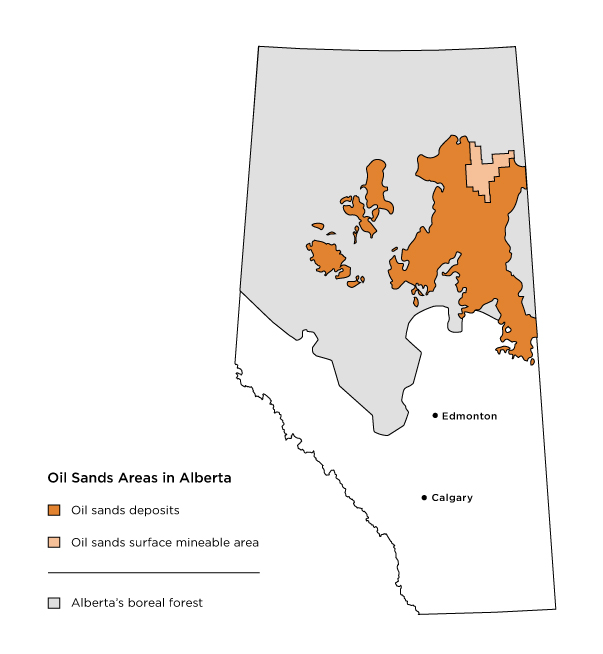Alberta’s oil sands are among the world’s largest deposits of crude oil—in fact, there are more than 165 billion barrels of bitumen in the ground. But with big energy reserves come big responsibilities. As the provincial regulator, our rigorous oil sands regulations and requirements continue to evolve to meet new challenges and opportunities. Companies must submit applications to us and receive our approval before developing oil sands.
What are oil sands?
Oil sands are a mixture of sand, clay, water, and bitumen. Bitumen is extra-heavy crude oil, some of which is so viscous that it cannot flow on its own. When bitumen is deposited at shallow depths, it can be surface mined. However, about 80 per cent of the recoverable bitumen reserves in Alberta are buried too deep to mine and can only be recovered by drilling wells. This is referred to as “in situ” recovery.
Heavy Oil
We distinguish between heavy oil and crude bitumen geographically:
- crude bitumen: heavy oil production inside designated oil sands areas
- crude oil: heavy oil production outside designated oil sands areas
Where the Oil Sands Are

This map of Alberta shows where active oil sands deposits are located. It also shows what portion is close enough to the surface to be mined. Within the 381 000 square kilometres of boreal forest, about 90 000 square kilometres contain active oil sands deposits. Of that, only 5 per cent of the deposits are close enough to the surface to be mined.
For a map of approved oil sands projects in Alberta, visit the Government of Alberta’s website.
How We Regulate Oil Sands Development
Visit our Oil Sands Requirements page for a full list of our oil sands development regulations and requirements. For more general information, read our EnerFAQs Oil Sands.
Inspections and Audits
We conduct regular inspections and audits to make sure that companies are following our requirements. Oil sands mines and operations are complex and often require several areas of expertise to properly assess them. For example, a single mine inspection can take up to one week to complete; our professional engineers and environmental scientists often inspect these mines as a team.
Compliance and Enforcement
We will take enforcement action if we find that a company isn’t complying or meeting our requirements, or if we find an unacceptable impact to the environment and public safety. We’ll also share our findings on our Compliance Dashboard.
In some cases, we will shut down a facility. If this happens, the company is only allowed to restart its operations once the noncompliance is addressed. We must be satisfied that it will not happen again, or at any of the company’s similar facilities.
Protecting Albertans and the Environment
We work with the Government of Alberta to manage the cumulative effects of oil sands development on air, water, land, and biodiversity at the regional level. Through regional planning, as well as other initiatives, Alberta is shifting to a more effective and efficient management system that considers the cumulative effects of all activities and improves integration across the economic, environmental, and social pillars. The AER is also in an MOU agreement with Canada's Oil Sands Innovation Alliance to explore knowledge gaps and new technologies related to environmental performance.


